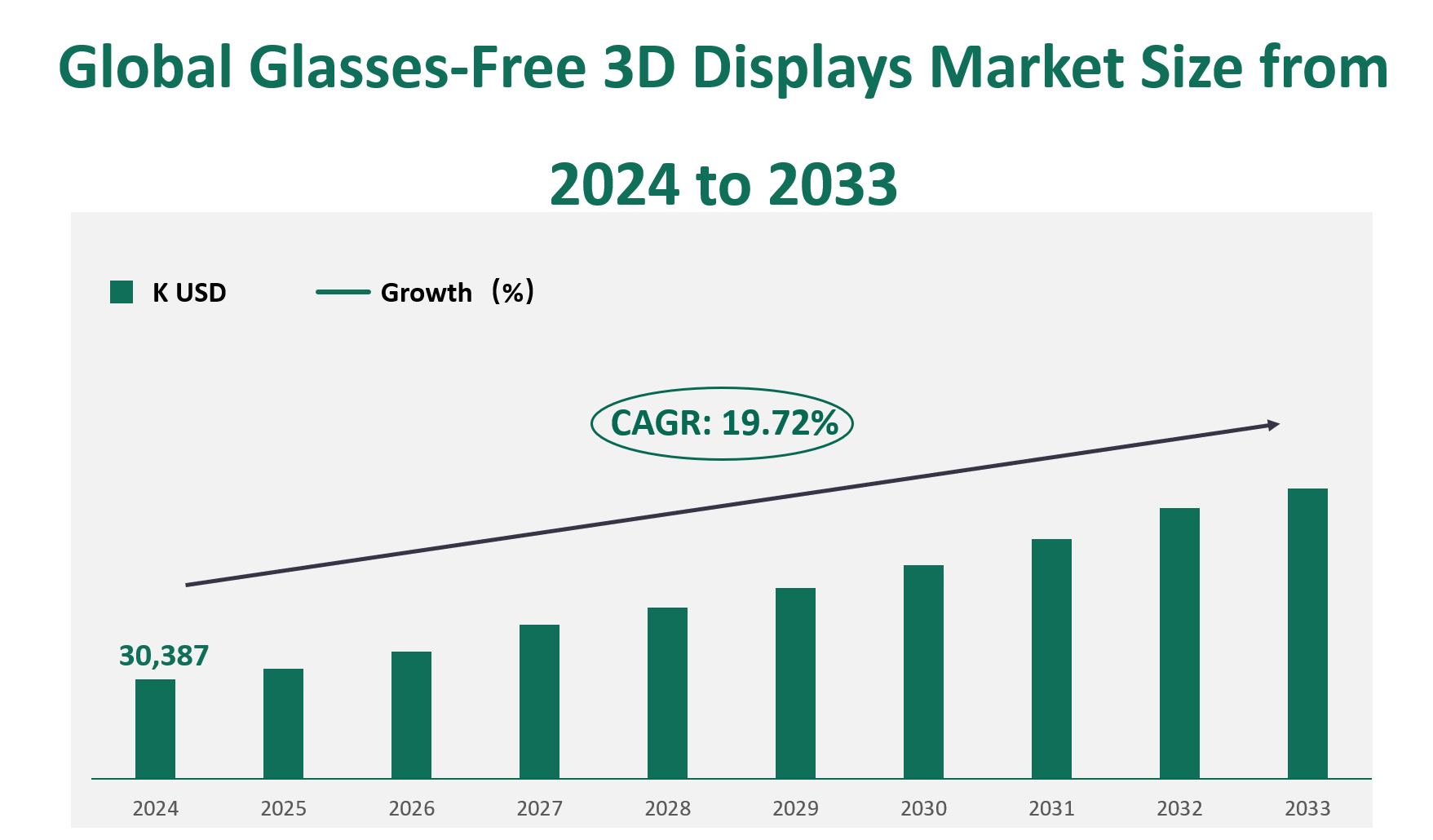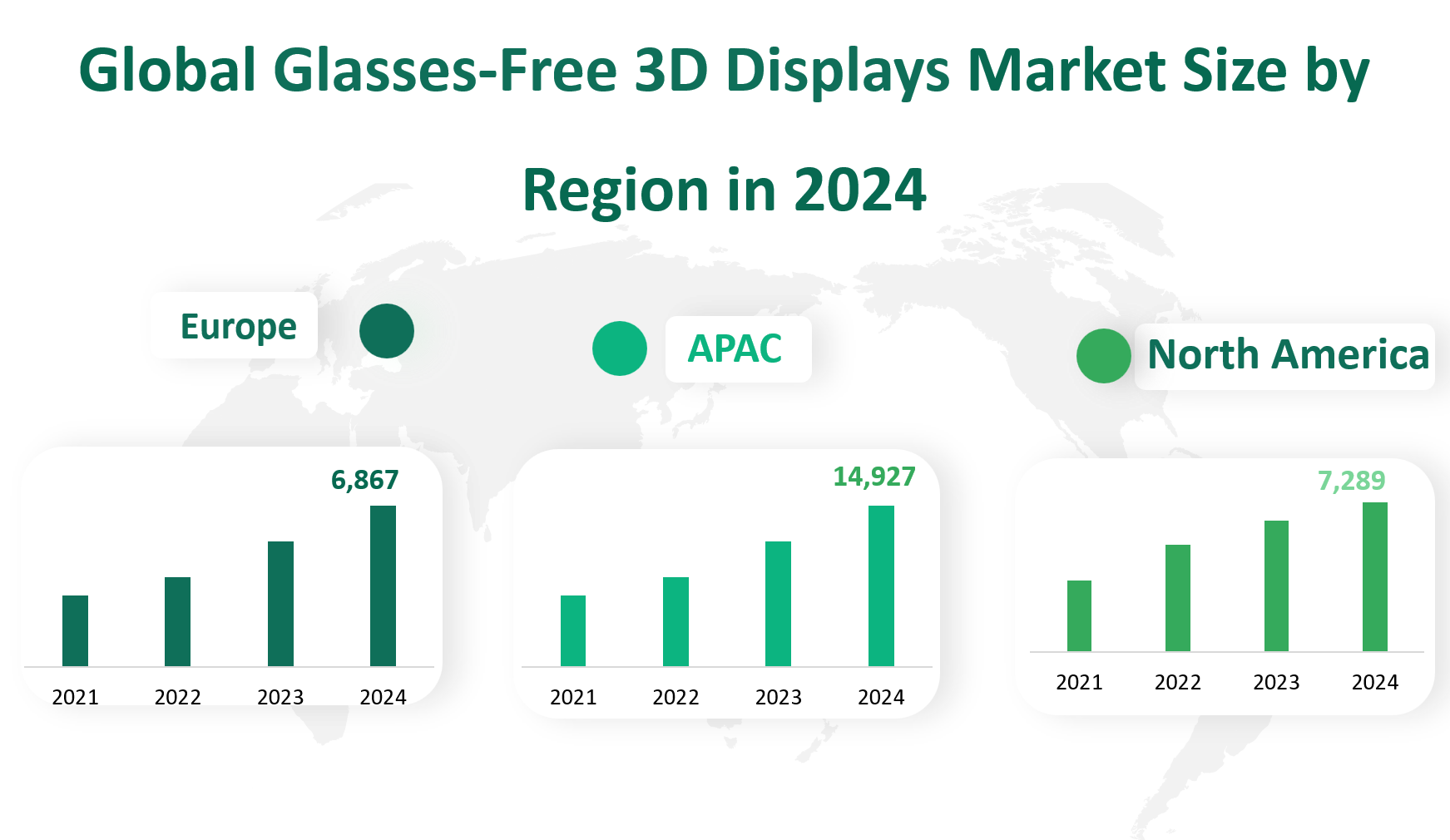1. Global Glasses-Free 3D Displays Market Insight Analysis
The global Glasses-Free 3D Displays market is projected to reach a value of 30,387 K USD in 2024, with a Compound Annual Growth Rate (CAGR) of 19.72% from 2024 to 2033.
Glasses-Free 3D Displays, also known as autostereoscopic displays, represent a significant leap forward in visual technology. These displays are designed to present three-dimensional images without requiring viewers to wear special glasses or headgear. This innovation eliminates the discomfort and inconvenience associated with traditional 3D viewing methods, making it more accessible and user-friendly for a wide range of applications.
The technology behind Glasses-Free 3D Displays involves various methods to create a 3D effect. One common approach is the use of lenticular lenses, which are arrays of magnifying lenses that direct different images to each eye, creating a stereoscopic effect. Another method is the parallax barrier, which uses a layer of liquid crystals to block certain parts of the screen, allowing each eye to see a slightly different image. Additionally, directional backlighting and direct imaging techniques are employed to enhance the 3D experience.
The development of Glasses-Free 3D Displays aims to overcome the limitations of current 3D technology, which often requires viewers to wear cumbersome glasses. By eliminating this requirement, Glasses-Free 3D Displays can provide a more natural and immersive viewing experience, making them suitable for applications such as advertising, entertainment, and consumer electronics. The potential for these displays to enhance visual content without the need for additional accessories has sparked significant interest and investment in the technology.
Figure Global Glasses-Free 3D Displays Market Size (M USD) and CAGR (2024-2033)

2. Driving and Limiting Factors of Glasses-Free 3D Displays Market Growth
The growth of the Glasses-Free 3D Displays market is driven by several key factors. Firstly, the increasing demand for immersive and interactive visual experiences in sectors such as advertising, entertainment, and consumer electronics is a major driver. The ability to create a 3D effect without the need for glasses makes these displays highly attractive for applications where viewer engagement is crucial.
Another driving factor is the technological advancements in display technology. Improvements in resolution, viewing angles, and brightness have made Glasses-Free 3D Displays more viable for commercial use. The development of high-resolution screens and advanced optical technologies has significantly enhanced the quality of the 3D effect, making it more realistic and appealing to consumers.
However, there are also several limiting factors that could hinder the growth of this market. One major challenge is the high cost associated with Glasses-Free 3D Displays. The technology required to produce these displays is complex and expensive, which can limit their adoption in price-sensitive markets. Additionally, the production of specialized 3D content is also costly and time-consuming, further restricting the widespread use of these displays.
Another limitation is the technical challenges that still need to be overcome. While significant progress has been made, issues such as limited viewing angles and potential for visual fatigue remain. These challenges can affect the overall user experience and limit the market’s expansion.
3. Technology Innovation and Corporate Mergers and Acquisitions in Glasses-Free 3D Displays Market
The Glasses-Free 3D Displays market has seen substantial technological innovation in recent years. Companies are continuously investing in research and development to improve the performance and reduce the cost of these displays. For example, advancements in lenticular lens technology have led to better viewing angles and higher resolution, while improvements in parallax barrier technology have resulted in more efficient light transmission and reduced ghosting effects.
Corporate mergers and acquisitions have also played a significant role in shaping the market. These strategic moves have allowed companies to expand their technological capabilities and market reach. For instance, Leyard’s acquisition of Planar Systems in 2015 enhanced Leyard’s position in the LED display market and provided it with additional resources to develop advanced Glasses-Free 3D Displays. Similarly, 3DIcon Corporation’s merger with Coretec Industries LLC in 2016 aimed to combine 3D volumetric display technologies with energy-related commercial solutions, showcasing the potential for cross-industry collaboration.
4. Global Glasses-Free 3D Displays Market Size by Type
Light Barrier Technology, also known as parallax barrier technology, uses a liquid crystal layer and a polarizing film to create a series of light and dark stripes (parallax barriers). These barriers block the left and right eyes’ views, creating a stereoscopic effect in the viewer’s brain. This technology is widely used due to its simplicity and effectiveness. In 2024, the market value for Light Barrier Technology is forecasted to be 12,412 K USD. This product type holds the largest market share, accounting for approximately 60.62% of the total Glasses-Free 3D Displays market.
Lenticular Lens Technology involves placing a layer of cylindrical lenses in front of the liquid crystal screen. These lenses project each sub-pixel in different directions, allowing the left and right eyes to see different sub-pixels and thus create a 3D effect. This technology is known for its high image quality and wide viewing angles. In 2024, the market value for Lenticular Lens Technology is projected to be 6,965 K USD, representing about 34.77% of the total market share.
Directional Backlight technology uses two sets of LEDs with different angles, combined with a high refresh rate LCD panel and a reflective prism module. This setup reflects images to the left and right eyes in a staggered arrangement of odd and even frames, creating a 3D effect. This technology is particularly useful in applications requiring high brightness and dynamic content. The market value for Directional Backlight in 2024 is forecasted to be 6,969 K USD, accounting for 34.77% of the market share.
Direct Imaging technology processes designated images and graphics through digital media to create a 3D effect. This method is highly customizable and can be tailored to various applications, making it suitable for niche markets. In 2024, the market value for Direct Imaging is projected to be 4,041 K USD, representing about 20.06% of the total market share.
Table Global Glasses-Free 3D Displays Market Size by Type in 2024
Market Size (K USD) 2024 | |
Light Barrier Technology | 12412 |
Lenticular Lens Technology | 6965 |
Directional Backlight | 6969 |
Direct Imaging | 4041 |
5. Global Glasses-Free 3D Displays Market Size by Application
Glasses-Free 3D TVs offer a revolutionary viewing experience by eliminating the need for 3D glasses. This technology allows viewers to enjoy immersive 3D content without the inconvenience of wearing special eyewear. In 2024, the market value for Glasses-Free 3D TVs is forecasted to be 4,559 K USD. This application holds a significant market share, accounting for about 15.01% of the total Glasses-Free 3D Displays market.
Advertising Display is one of the most promising applications for Glasses-Free 3D Displays. This technology enhances the visual impact of advertisements, making them more engaging and effective. In 2024, the market value for Advertising Display is projected to be 20,878 K USD, representing about 68.76% of the total market share.
Glasses-Free 3D Displays in mobile devices offer a unique and immersive user experience. This technology allows users to enjoy 3D content on their smartphones and tablets without the need for additional accessories. In 2024, the market value for Glasses-Free 3D Displays in Mobile Devices is forecasted to be 3,278 K USD, accounting for about 10.80% of the total market share.
Table Global Glasses-Free 3D Displays Market Size by Application in 2024
Application | Market Size (K USD) 2024 |
TV | 4559 |
Advertising Display | 20878 |
Mobile Devices | 3278 |
Other | 1672 |
6. Global Glasses-Free 3D Displays Market by Top Regions
North America is a significant player in the Glasses-Free 3D Displays market, with a projected value of 7,289 K USD in 2024. This region has been at the forefront of technological advancements and has a strong presence of major manufacturers and research institutions. The United States, in particular, is a key market due to its robust consumer electronics industry and high demand for advanced display technologies.
Europe is another major market, with an estimated value of 6,867 K USD in 2024. European countries such as Germany, the UK, and France have been actively involved in the development and adoption of Glasses-Free 3D Displays. The region benefits from a high level of technological sophistication and a strong focus on innovation, which drives the market forward.
Asia-Pacific is the largest regional market by revenue, with a projected value of 14,927 K USD in 2024. This region’s dominance is attributed to its large consumer base, rapid technological advancements, and significant investments in research and development.
Latin America is expected to reach a value of 652 K USD in 2024. While this region is smaller in comparison to North America, Europe, and Asia-Pacific, it is experiencing rapid growth due to increasing demand for advanced display technologies in emerging economies such as Brazil and Mexico.
Middle East & Africa is projected to have a market value of 653 K USD in 2024. This region is also witnessing significant growth, driven by investments in infrastructure and the adoption of advanced technologies in countries like Saudi Arabia and the UAE.
Figure Global Glasses-Free 3D Displays Market Size by Region in 2024

7. Global Glasses-Free 3D Displays Market Analysis by Major Players
7.1 Evistek
Company Introduction and Business Overview: Evistek was established in 2005 and is headquartered in China. The company specializes in the development of autostereoscopic 3D displays and related technologies. Evistek offers a range of products, including Glasses-Free 3D TVs, advertising machines, and tablets. The company’s core technology includes 3D video processing, viewpoint conversion, motion estimation, and LED dynamic backlight control.
Products Offered: Evistek’s flagship product is the 98-inch 4K Ultra HD Glasses-Free 3D TV, which features up to 54 viewpoints and a strong, lifelike 3D effect. The company also offers Glasses-Free 3D advertising machines and tablets, which are designed for commercial use.
7.2 Stream TV Networks
Company Introduction and Business Overview: Stream TV Networks, established in 2009, is a Philadelphia-based new media company. The company has developed a breakthrough Glasses-Free 3D display technology called Ultra-D™, which eliminates the need for special glasses and provides a superior 3D viewing experience.
Products Offered: Stream TV Networks’ Ultra-D™ technology is a combination of proprietary hardware and software. The company’s products include Glasses-Free 3D displays that can be integrated into various devices, such as TVs and advertising screens.
7.3 Alioscopy
Company Introduction and Business Overview: Alioscopy, founded in 1999, is a pioneer in the field of Glasses-Free 3D displays. The company holds an international patent portfolio covering key aspects of the technology and offers autostereoscopic 3D screens that display three-dimensional images without the need for glasses.
Products Offered: Alioscopy’s products include Glasses-Free 3D displays that can be used for digital signage, advertising, marketing, and professional imaging. The company’s displays support multi-angle viewing and can display both 2D and proprietary 3D content.

